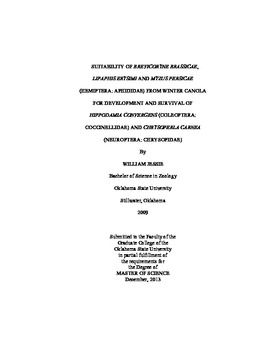| dc.contributor.advisor | Giles, Kristopher L. | |
| dc.contributor.author | Jessie, William | |
| dc.date.accessioned | 2015-06-17T20:06:25Z | |
| dc.date.available | 2015-06-17T20:06:25Z | |
| dc.date.issued | 2013-12-01 | |
| dc.identifier.uri | https://hdl.handle.net/11244/14908 | |
| dc.description.abstract | Winter canola (Brassica napus L.) is a high energy oilseed crop recently introduced to the Southern Great Plains growing region. As a cruciferous plant, it introduces to typically low-prey landscapes a habitat with very high populations of potentially toxic cabbage aphids (Brevicoryne brassicae L.) and turnip aphids (Lipaphis erysimi Kaltenbach). These aphids are capable of sequestering plant volatiles from host plants to arm themselves with a potent chemical defense system, dependent upon the distribution and concentration of these compounds within the plant. Also a frequent pest of winter canola, the green peach aphid (Myzus persicae Sulzer) is a generalist herbivore unable to sequester such toxic compounds. This study attempts to conclusively evaluate the suitability of all three aphid species commonly attacking winter canola for two abundant natural enemies that occur in Southern Great Plains, the convergent lady beetle (Hippodamia convergens Gu�rin-M�neville) and the common green lacewing (Chrysoperla carnea Stephens) and determine whether these predators exhibit preferences among these aphid species. Prey species and daily prey quantity provided to predator larvae significantly affected developmental times and adult weights. Diets of turnip and cabbage aphids always resulted in slower developmental times and smaller adult weights than diets of green peach aphids and pea aphids. While developmental times of each predator decreased as daily prey quantity increased, adult weight of predators was significantly less when fed diets of Brassica specialist aphids. Survival of predators on all four diets was relatively high regardless of daily prey quantity. These results indicates that although cabbage and turnip aphids were suitable prey for H. convergens<italic/> and C. carnea, qualitative differences likely exist between Brassica specialist aphids and the green peach aphid. Furthermore, green peach aphids feeding on winter canola should be considered high-quality prey items, as each predator's performance on these aphids was very similar to that of pea aphids. While no preferences for aphid prey were detected, larvae of each predator species frequently consumed more green peach aphids than either cabbage or turnip aphids. These results suggest winter canola has the potential to serve as a source habitat for H. convergens and C. carnea. | |
| dc.format | application/pdf | |
| dc.language | en_US | |
| dc.publisher | Oklahoma State University | |
| dc.rights | Copyright is held by the author who has granted the Oklahoma State University Library the non-exclusive right to share this material in its institutional repository. Contact Digital Library Services at lib-dls@okstate.edu or 405-744-9161 for the permission policy on the use, reproduction or distribution of this material. | |
| dc.title | Suitability of Brevicoryne Brassicae, Lipaphis Erysimi and Myzus Persicae (Hemiptera: Aphididae) from Winter Canola for Development and Survival of Hippodamia Convergens (Coleoptera: Coccinellidae) and Chrysoperla Carnea (Neuroptera: Chrysopidae) | |
| dc.type | text | |
| dc.contributor.committeeMember | Rebek, Eric J. | |
| dc.contributor.committeeMember | Payton, Mark E. | |
| osu.filename | Jessie_okstate_0664M_13117.pdf | |
| osu.accesstype | Open Access | |
| dc.description.department | Entomology | |
| dc.type.genre | Thesis | |
